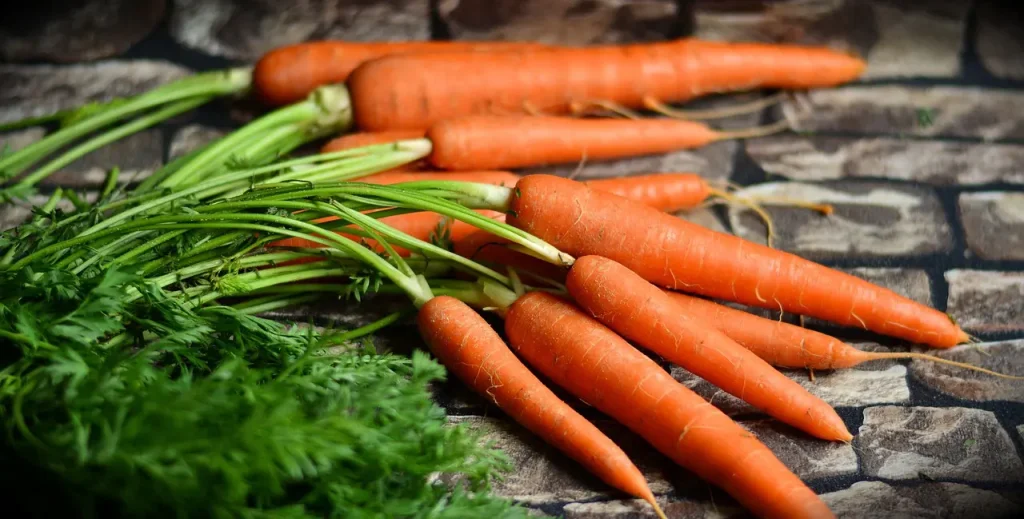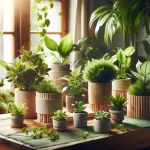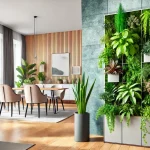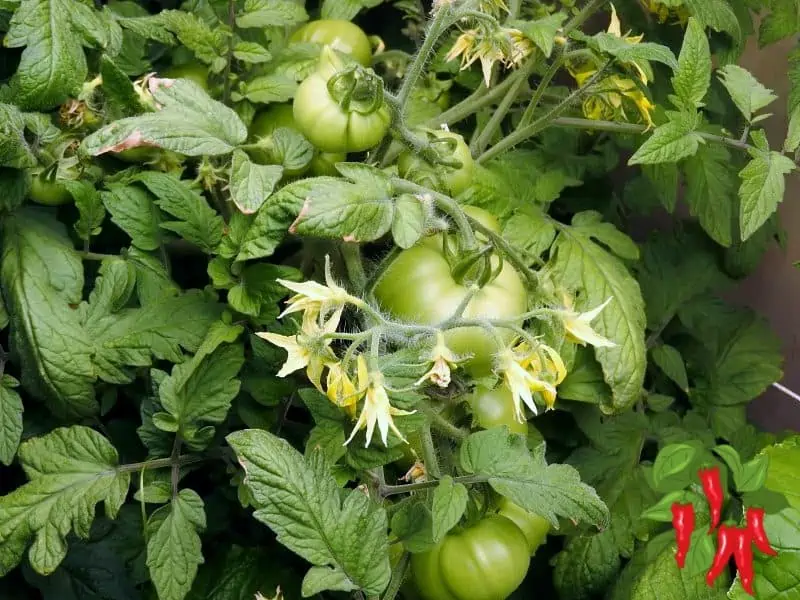This post may contain affiliate links. If you buy something from one of our links we may earn a commission. Thanks

Carrots are popular and versatile root vegetables that can be enjoyed raw, cooked, or juiced. They are one of the most popular vegetables.
While they are typically grown in an outdoor vegetable garden, the best thing is that it is possible to grow carrots indoors as well.
In fact, indoor carrot growing can be a fun and rewarding way to enjoy fresh carrots year-round, even in small spaces.
Plus, growing your own carrots allows you to control the quality of the soil and water, which can result in healthier and tastier carrots than those at the grocery store.
How To Grow Carrots Indoors
If you’re interested in how to grow carrots indoors, here’s a step-by-step guide to getting you started.
Step 1: Choose the right carrot variety
Not all carrot varieties are suitable for indoor growth, so it’s important to choose a variety of carrot that is specifically meant for indoor or container gardening.
Here are some good carrot varieties for growing indoors:
Parisian: These are small, round carrots that are well-suited for growing in containers. They only grow to be about 2-3 inches long, so they don’t require a lot of space.
Thumbelina: Another small variety, Thumbelina carrots are perfect for growing in pots or containers. They only grow to be about 3-4 inches long, so they don’t require a lot of depth to grow.
Danvers 126: This variety is a good choice for indoor growing because it is resistant to cracking and splitting. It grows to be about 6-7 inches long, so it will require a bit more space than the other varieties on this list.
Little Finger: As the name suggests, this is another small carrot variety that is well-suited for indoor growing. It grows to be about 3-4 inches long and is very sweet and flavorful.
Nantes: This is a classic carrot variety that is known for its sweet flavor and tender texture. It grows to be about 6-7 inches long and is a good choice for indoor growing.
Chantenay: Chantenay carrots are a variety of carrot that is known for their short, squat shape and sweet, crisp flavor. They are a good choice for indoor growing because they don’t require a lot of depth to grow and are resistant to cracking and splitting. Chantenay carrots grow to be about 5-6 inches long and are best harvested when they are about 2 inches in diameter. They are a good source of vitamins and minerals and can be eaten raw or cooked.
It’s important to note that all of these varieties will require well-draining soil and plenty of sunlight to grow successfully.
You may need to use grow lights to provide enough light for your plants if you don’t have a sunny window or balcony.
It’s also important to consider the size of your container and the amount of space you have available.
If you have a smaller container or limited space, look for a shorter type of carrot variety that doesn’t require as much room to grow.
Potato grow bags work well for varieties that need a deeper pot but plastic pots work well too. For most carrots, you need a deeper rather than a large container.
There are orange carrots of course but there are also yellow, red, purple, and white carrots too. So you can add some variety to your indoor garden.
Step 2: Prepare the container and soil
The type of container you use is important for indoor carrot growing. A container with drainage holes is essential to prevent the soil from becoming waterlogged, which can lead to root rot.
A lightweight, well-draining soil mix is also important for carrots and other root crops.
Outdoors carrots are often planted in a raised garden bed and sandy soil is preferred so you will want to try and duplicate this indoors for good quality carrots.
You can purchase a premade potting mix specifically formulated for indoor gardening, or you can use coco coir.
Avoid using perlite or other stones because they can cause the forking of the carrot roots.
To provide proper drainage, add a layer of gravel or stones to the bottom of the container before adding the soil.
This will help to prevent excess water from accumulating and ensure that your carrots have access to the proper amount of moisture.
Step 3: Plant the seeds
When planting carrot seeds, it’s important to follow the instructions on the seed packet.
Generally, carrots seeds should be planted about 1/4 inch deep and spaced about 1/2 inch apart.
If you’re using a small container, you can plant the seeds closer together, as long as they have enough room to grow.
Some people like to presoak their seeds for faster germination. I find it makes sowing much harder so I don’t do it.
You can always thin out extra plants later and harvest extra plants as baby carrots.
After planting the seeds on the soil surface, cover them with a thin layer of soil and gently press down to ensure good soil-to-seed contact.
Water the seeds gently, using a misting bottle to avoid disturbing the seeds.
Carrots are a cool weather crop and are happy at a 60-70 degree air and soil temperature.
Carrot seeds can be slow to germinate and can take a long time, 14-21 days to sprout so be patient.
Step 4: Provide adequate light and moisture
Carrots need plenty of light to grow properly, so it’s important to provide them with as much light as possible. They prefer full sun.
If you don’t have a sunny location in your home, you may need to use a grow light or move the container to a sunny spot during the day.
Water your carrot plants regularly but be careful not to over-water. The soil should be moist, but not soggy. You can check the moisture level by sticking your finger about an inch into the soil. If it feels dry, it’s time to water.
Step 5: Harvest and store the carrots
When your carrots are ready to harvest, simply pull your carrot crop gently out of the soil. The exact timing will depend on the variety you have chosen, but most carrots are ready to harvest in about 60 to 70 days.
Carrots can be stored in a variety of ways to help them stay fresh for as long as possible. One option is to store them in the refrigerator, either in a plastic bag or in a covered container.
Alternatively, you can store carrots in a root cellar or other cool, dark, and humid location.
To help prevent spoilage, be sure to remove any carrot tops from the carrots before storing them, as the greens can draw moisture from the roots and cause them to become withered and limp.
Additionally, be sure to keep the carrots away from fruits and vegetables that produce ethylene gas, as this gas can cause the carrots to spoil more quickly.
Properly stored indoor-grown carrots can keep for several weeks or even longer, depending on the variety and how fresh they were when they were harvested.
Some types of carrots, such as “storage” varieties, are specifically bred to have a longer shelf life and can keep for several months when stored correctly.
To maximize the shelf life of your indoor-grown carrots, it is important to store them in a location that is cool (but not freezing), dark, and humid.
A refrigerator set to a temperature between 32-40°F (0-4°C) is a good option for storing carrots. If you do not have access to a refrigerator, a root cellar or other cool, dark, and humid location will also work.
Regardless of where you store your carrots, be sure to check them regularly for any signs of spoilage, such as softness, discoloration, or the presence of mold.
If you notice any of these signs, it is best to discard the affected carrots to prevent them from contaminating the rest of your stash.
FAQs
What is the best way to plant carrot seeds indoors?
To plant carrot seeds indoors, fill a container with a lightweight, stone-free, well-draining soil mix.
Sow the seeds about 1/4 inch deep and 1/2 inch apart, and cover them with a layer of soil.
Gently water the seeds by misting them with a spray bottle to avoid disturbing them.
How much light do indoor carrot plants need?
Carrot plants need plenty of light to grow properly, so it’s important to provide them with as much light as possible.
If you don’t have a sunny location in your home, you may need to use a grow light or move the container to a sunny spot during the day.
How do I know when my indoor carrots are ready to harvest?
The exact timing will depend on the variety of carrots you are growing, but most carrots are ready to harvest in about 60 to 70 days.
To check if your carrots are ready, gently pull on one of the plants. If the carrot comes out of the soil easily, it is ready to be harvested.
How do I store my indoor-grown carrots?
To store your indoor-grown carrots, keep them in a cool, dark place, such as a basement or root cellar.
Alternatively, you can wrap them in damp paper towels and place them in a plastic bag in the refrigerator. With proper storage, your indoor-grown carrots should stay fresh for several weeks.
Final Thoughts
Growing carrots indoors can be a fun and rewarding way to enjoy fresh carrots year-round, even in small spaces.
By following these simple steps, you can successfully grow your own carrots indoors:
• Choose the right carrot variety: considering the size of your container and the amount of space you have available.
• Prepare the container and soil: using a container with drainage holes and a lightweight, well-draining soil mix.
• Plant the seeds: following the instructions on the seed packet.
• Provide adequate light and moisture: using a grow light if necessary and watering regularly but not overwatering.
• Harvest and store the carrots when they are ready: keeping them in a cool, dark place or wrapping them in damp paper towels and storing them in the refrigerator.
With a little bit of effort, you can enjoy fresh, homegrown carrots anytime, regardless of the season.
So why not give indoor carrot growing a try? You might be surprised at how easy and satisfying it can be. Here’s how to start a backyard urban garden.









